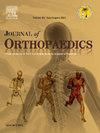全髋关节置换术后髋关节脊柱综合征患者脊柱骨盆参数变化与下背痛之间的相关性:短期随访研究
IF 1.5
Q3 ORTHOPEDICS
引用次数: 0
摘要
背景很多髋关节骨性关节炎(HOA)患者伴有下背部疼痛(LBP)和髋关节疼痛,这种症状被命名为髋关节脊柱综合征(HSS)。本研究的目的是利用脊柱骨盆参数和多种临床评分系统分析全髋关节置换术(THA)治疗髋关节综合征的疗效。根据纳入和排除标准,将 52 例患者纳入研究。分析患者基线信息,拍摄术前和术后6个月的脊柱全长侧位片,测量PI、PT、LL、SS和SVA。计算术前和术后6个月的Oswestry残疾指数评分(ODI)、视觉模拟量表评分(VAS)和髋关节哈里斯评分(HHS)。 结果 共纳入52例髋关节脊柱综合征患者进行随访,并根据术后背痛是否缓解分为两组:背痛持续组和背痛改善组。其中,33 人(63%)的背痛得到缓解。两组患者术后的 LL、SVA 和 PI-LL 有明显差异(P < 0.05)。THA术后LBP改善的患者脊柱参数变化有明显差异,LL增加,SVA减少,PI-LL匹配。术后临床评分量表显示,LBP未改善组的HHS评分明显低于LBP改善组,且LBP未改善组术后各项临床评分均较差。这些脊柱骨盆参数可能是THA术后腰背痛改善机制的关键因素。本文章由计算机程序翻译,如有差异,请以英文原文为准。
Correlation between changes in spinal pelvic parameters and lower back pain in patients with hip spinal syndrome after total hip arthroplasty: A short-term follow-up study
Backgroud
A number of patients with hip osteoarthritis (HOA) have lower back pain (LBP) and hip joint pain, a symptom named hip spine syndrome (HSS). The purpose of this study is to analyze the efficacy of total hip arthroplasty (THA) in treating HSS using spinal pelvic parameters and multiple clinical scoring systems.
Methods
We prospectively collected HOA patients who underwent THA by surgeons from the same medical research center. 52 patients were included in the study according to the inclusion and exclusion criteria. Analyze patient baseline information, take full-length lateral radiographs of the spine before and 6 months after surgery, measure PI, PT, LL, SS, and SVA. Calculate the Oswestry Disability Index score (ODI), Visual Analog Scale score (VAS), and Hip Harris score (HHS) before and 6 months after surgery.
Results
A total of 52 patients with hip spine syndrome were included for follow - up and were divided into two groups based on whether postoperative back pain was relieved: the group with continued in back pain and the group with improvement in back pain. Among them, 33 people (63 %) achieved relief in back pain. There were significant differences (p < 0.05) in postoperative LL, SVA, and PI-LL between the two groups. There were significant differences in spinal parameter changes among patients with improved LBP after THA, with increased LL, decreased SVA, and matched PI-LL. The postoperative clinical scoring scale showed that the HHS score of the group without improvement in LBP was significantly lower than that of the group with improvement in LBP, and all clinical scores of the group without improvement in LBP were poor after surgery.
Conclusion
There was a significant difference in the changes of spinal pelvic parameters in patients with improved LBP after THA, i.e., LL was elevated and SVA were decreased, PI-LL maintains matching. These spinal pelvic parameters may be key factors in the mechanism of low back pain improvement after THA surgery.
求助全文
通过发布文献求助,成功后即可免费获取论文全文。
去求助
来源期刊

Journal of orthopaedics
ORTHOPEDICS-
CiteScore
3.50
自引率
6.70%
发文量
202
审稿时长
56 days
期刊介绍:
Journal of Orthopaedics aims to be a leading journal in orthopaedics and contribute towards the improvement of quality of orthopedic health care. The journal publishes original research work and review articles related to different aspects of orthopaedics including Arthroplasty, Arthroscopy, Sports Medicine, Trauma, Spine and Spinal deformities, Pediatric orthopaedics, limb reconstruction procedures, hand surgery, and orthopaedic oncology. It also publishes articles on continuing education, health-related information, case reports and letters to the editor. It is requested to note that the journal has an international readership and all submissions should be aimed at specifying something about the setting in which the work was conducted. Authors must also provide any specific reasons for the research and also provide an elaborate description of the results.
 求助内容:
求助内容: 应助结果提醒方式:
应助结果提醒方式:


